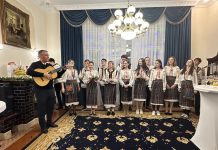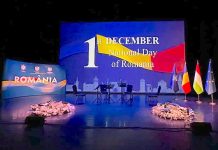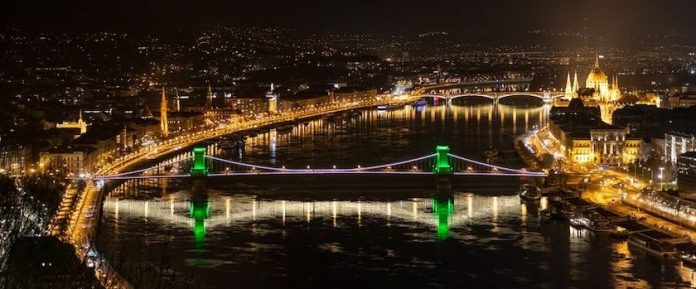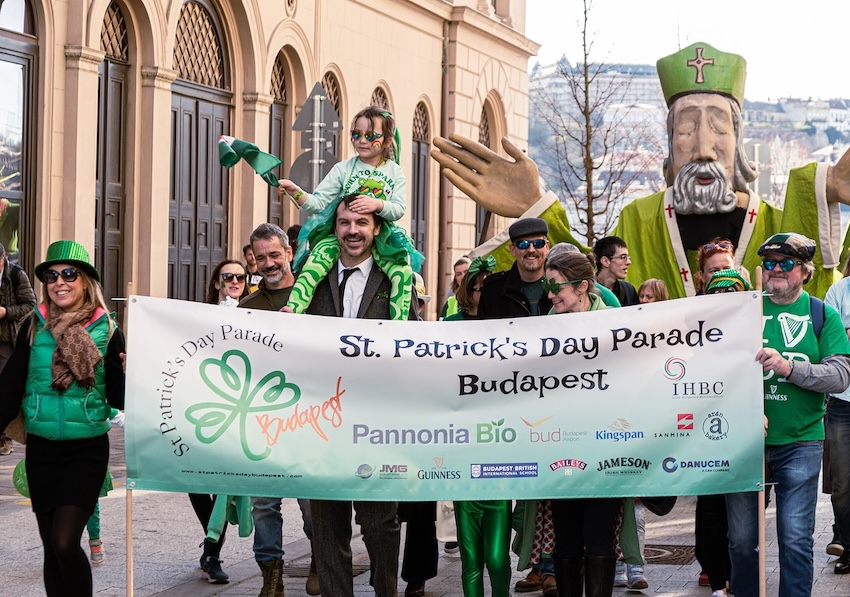Edited by Anna Popper
Observed annually on 17 March, St. Patrick’s Day commemorates the death anniversary of the Romano-British Christian missionary and bishop, who is revered as the primary patron saint of Ireland.

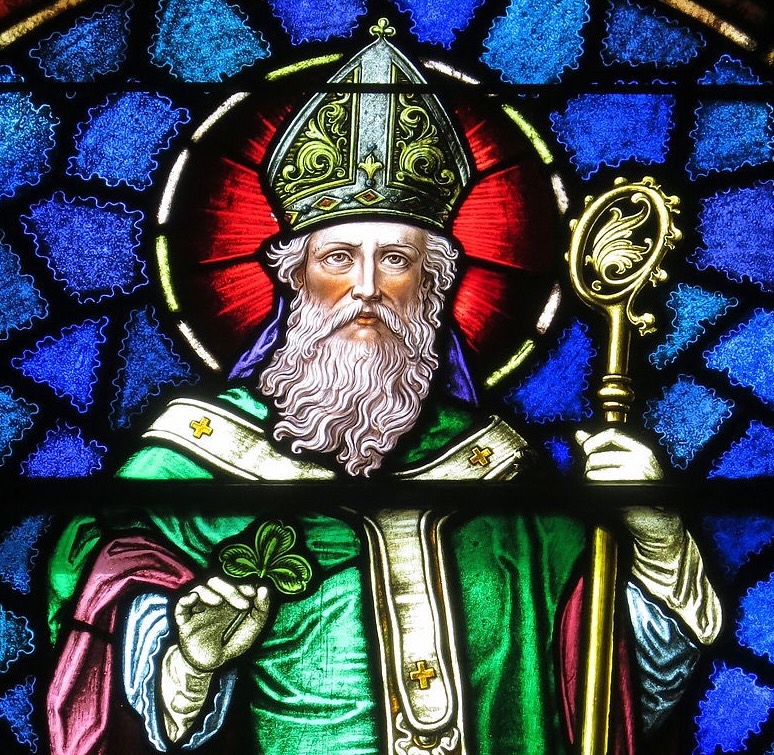
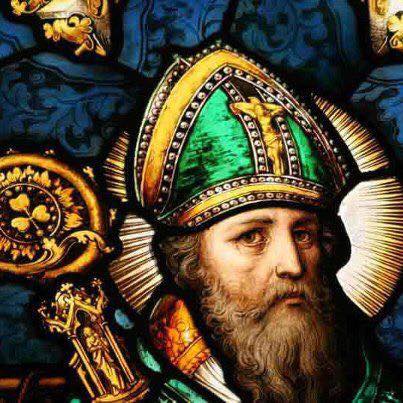
Green Parade in the Heart of Budapest
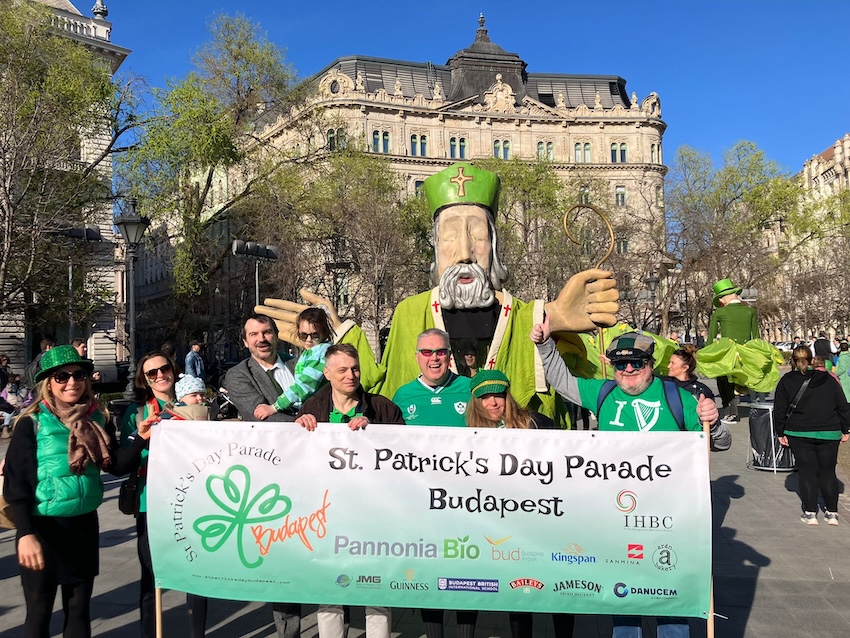
In 2025, the St. Patrick’s Festival & Parade took place on Sunday, 16 March, in the heart of the Hungarian capital. Organized by the Irish-Hungarian Business Circle (IHBC) in collaboration with the Embassy of Ireland to Hungary, the event transformed Szabadság tér into a sea of green as hundreds of participants gathered to celebrate. This vibrant festival is an unmissable occasion not only for the Irish diaspora, but also for families across Budapest.
Since its inception in 2011, this annual event has become a cherished tradition, bringing together Irish nationals, Hungarians, and people of diverse backgrounds to embrace Ireland’s rich cultural heritage, fostering unity and joy among all participants.
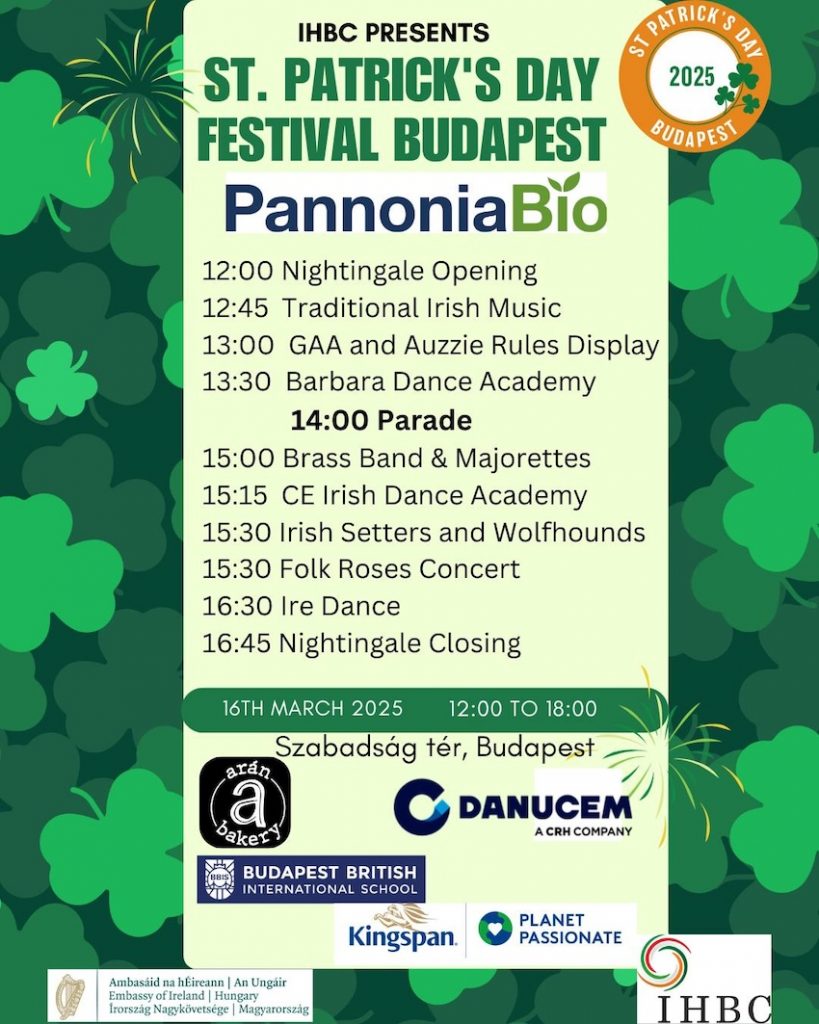

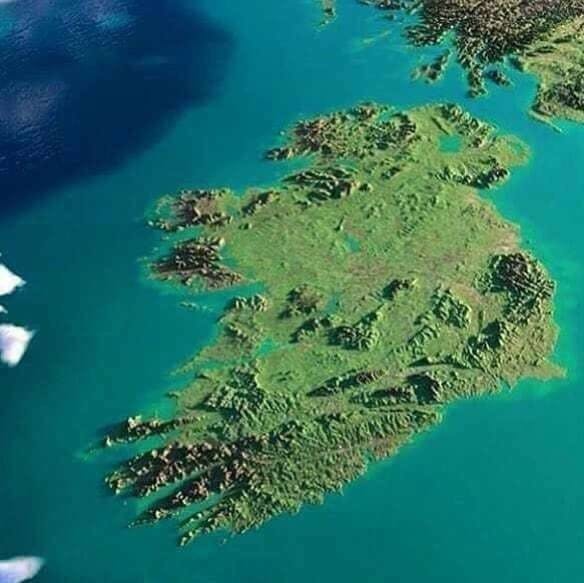
The parade kicked off in the afternoon, led by the great man himself – St. Patrick – and wound through District V, passing some of Budapest’s iconic landmarks, including the Parliament and St. Stephen’s Basilica, before returning to Szabadság tér for more entertainment. Festival attendees were treated to fantastic live performances, featuring a blend of traditional and contemporary music and dance. Budapest Gaels GAA showcased Gaelic football and hurling on Szabadság tér, while dog lovers could meet a pack of pedigree Red Setters and Irish Wolfhounds. Alongside traditional Irish food and drinks generously provided by the parade’s sponsors, families and festivalgoers enjoyed balloon bending and face painting.

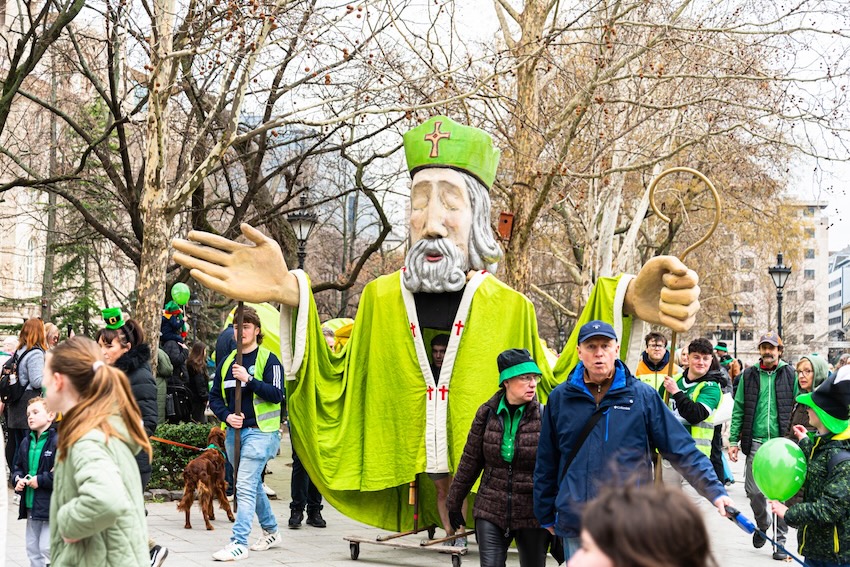
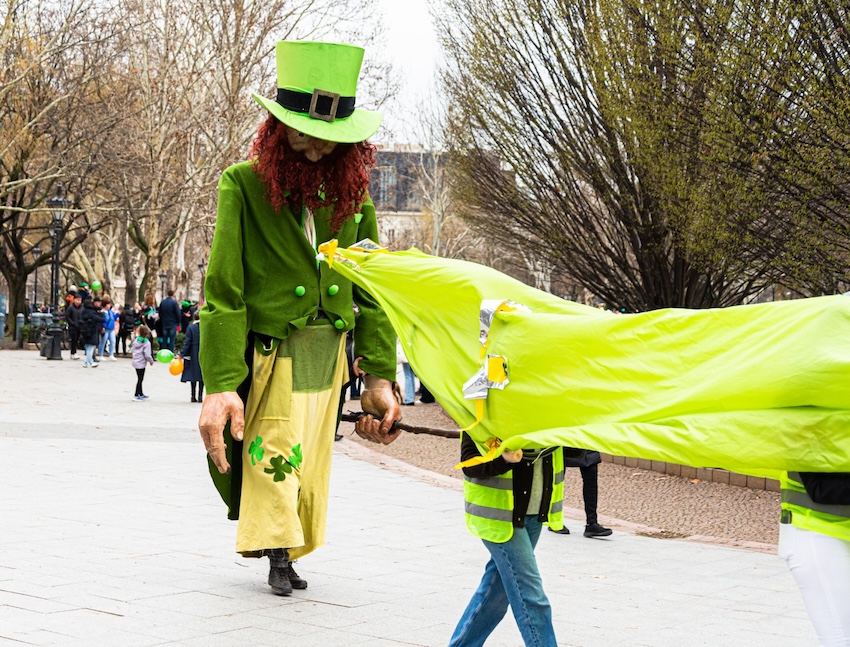
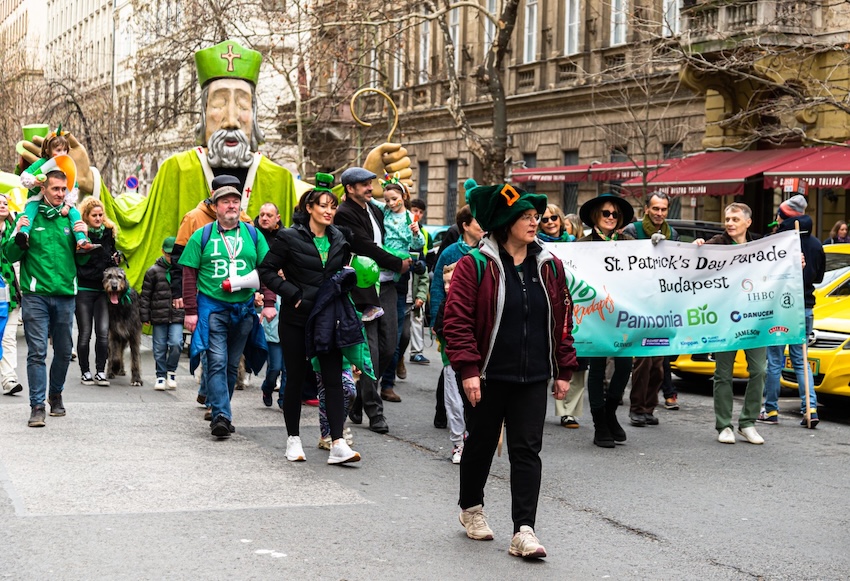
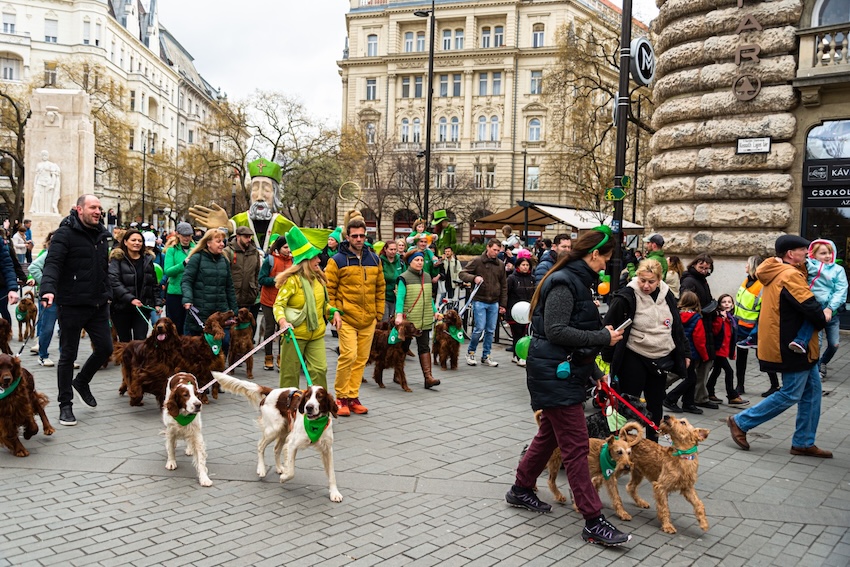
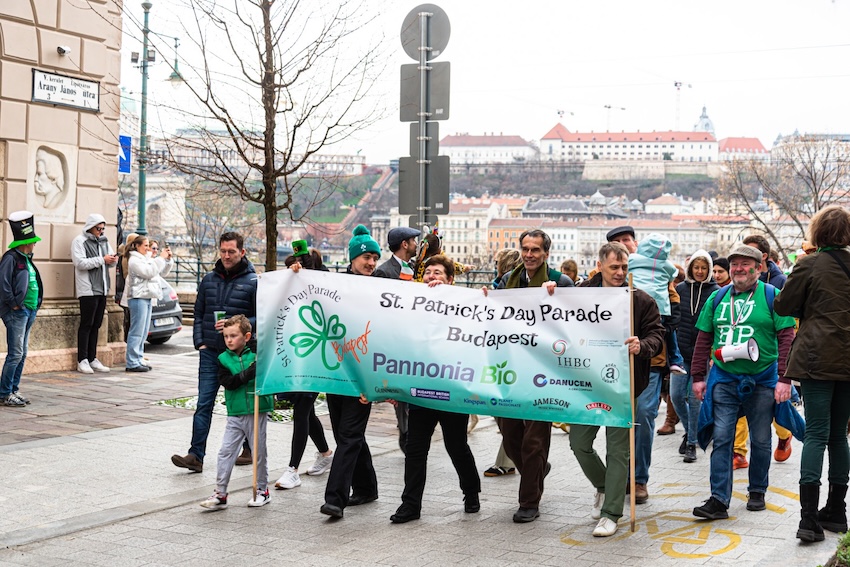
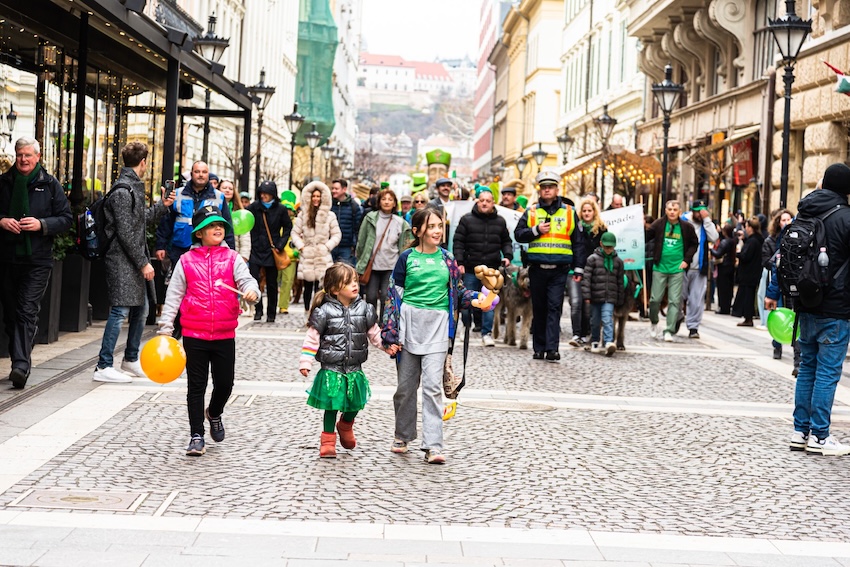

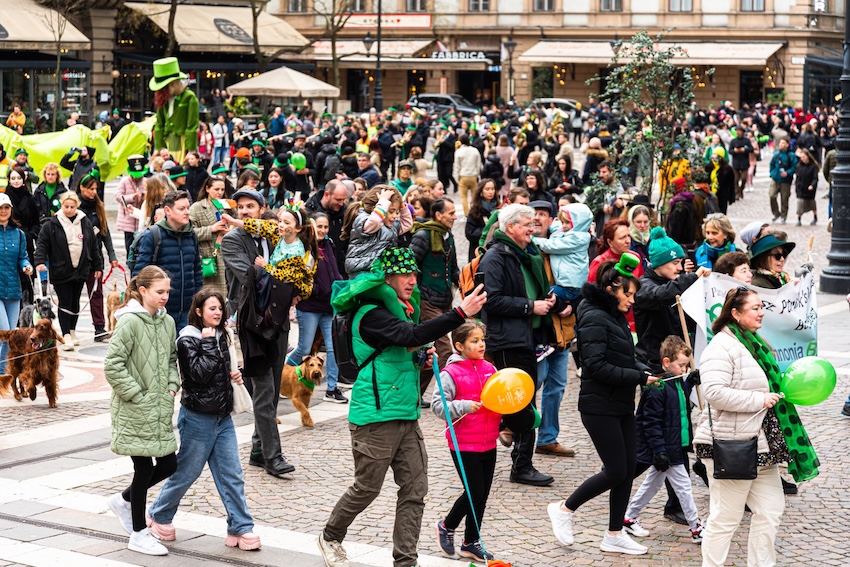
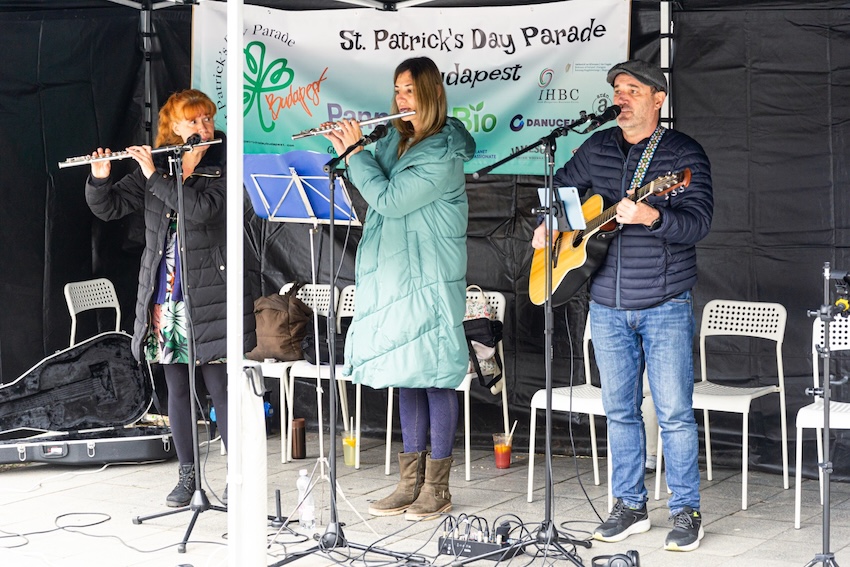
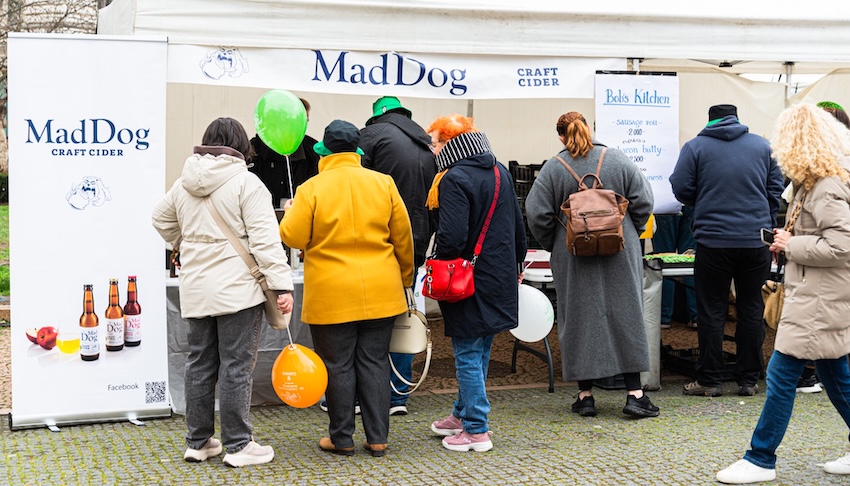
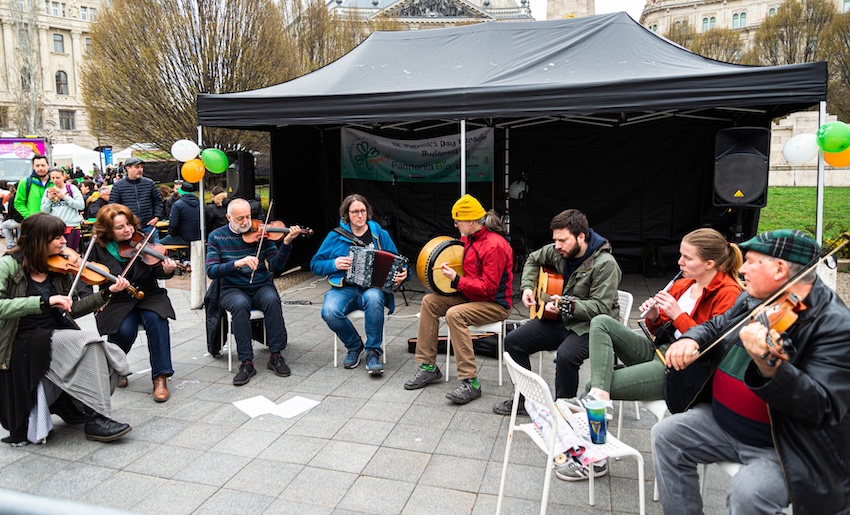
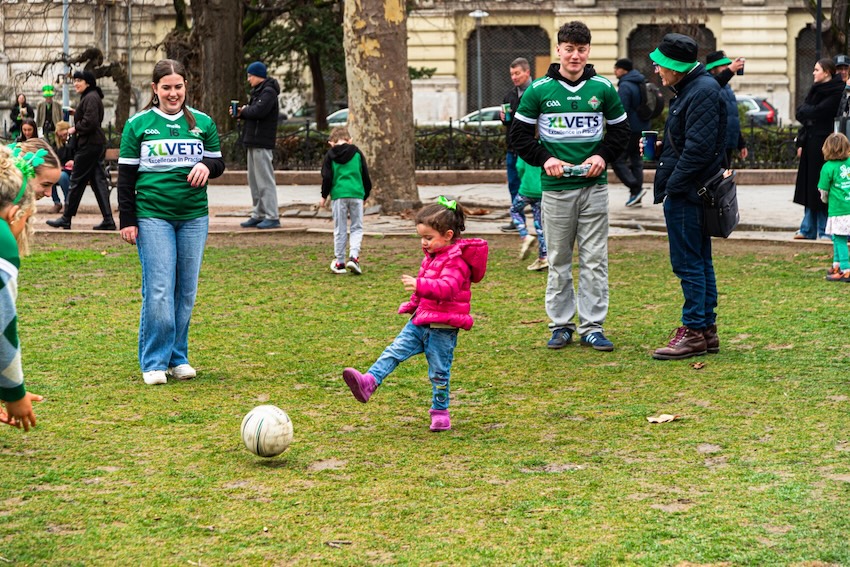
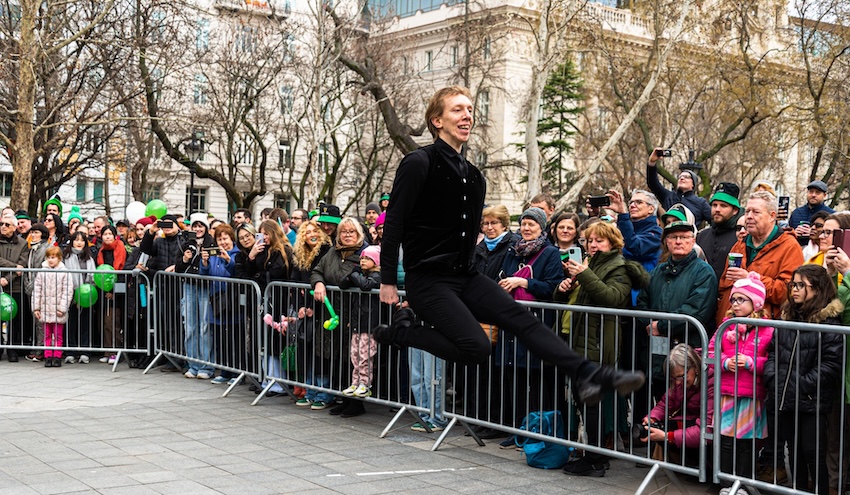

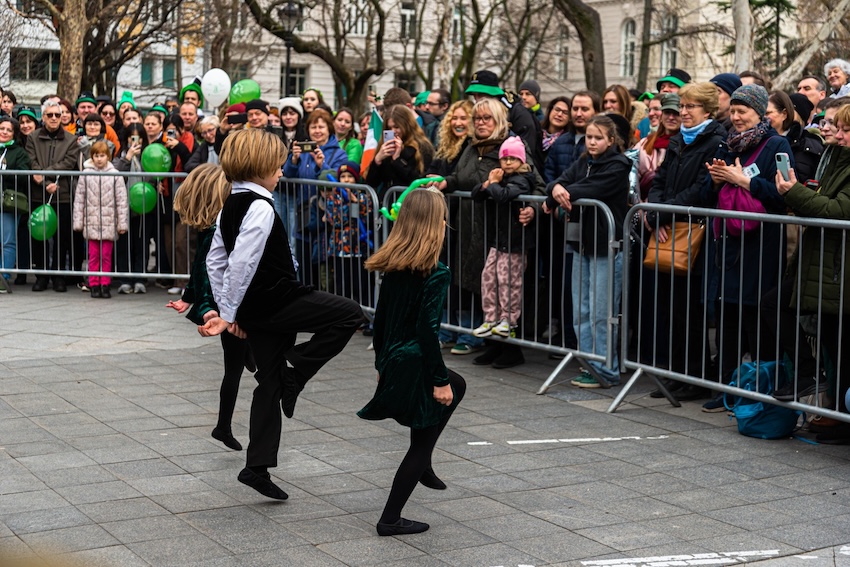
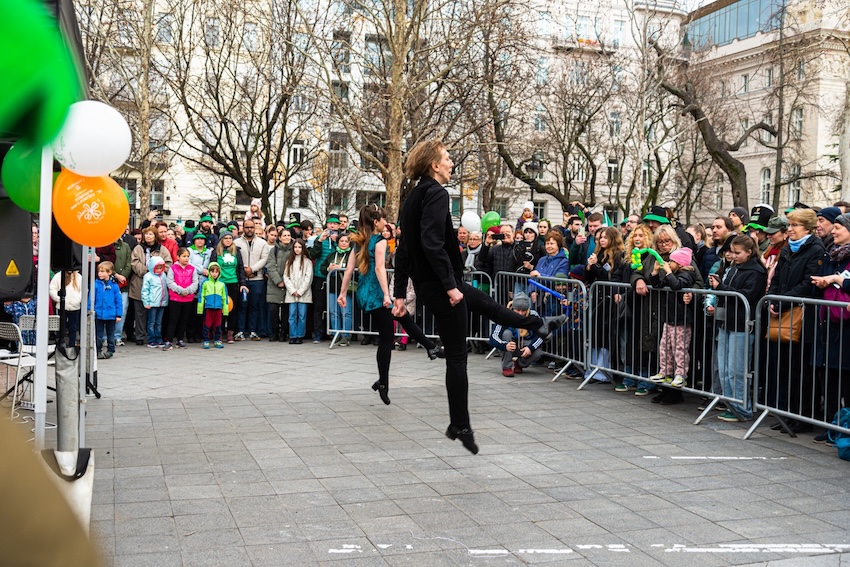
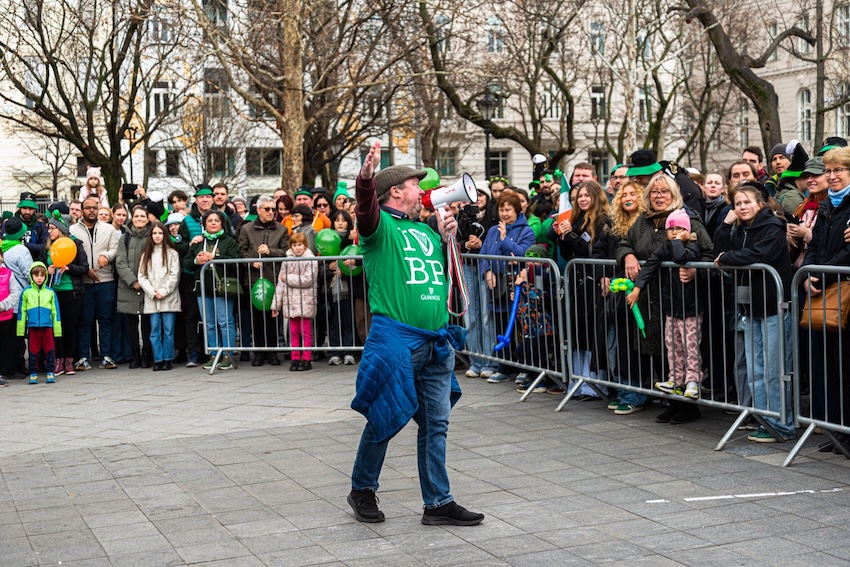
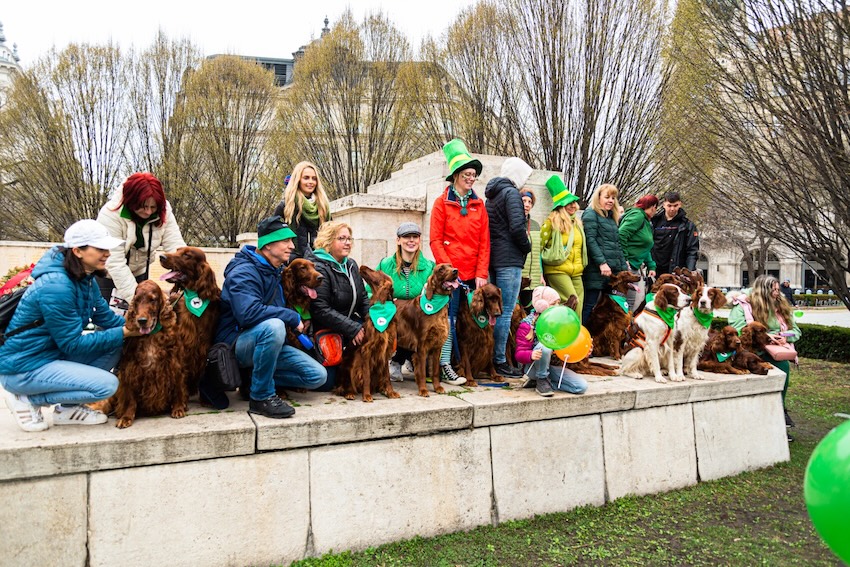
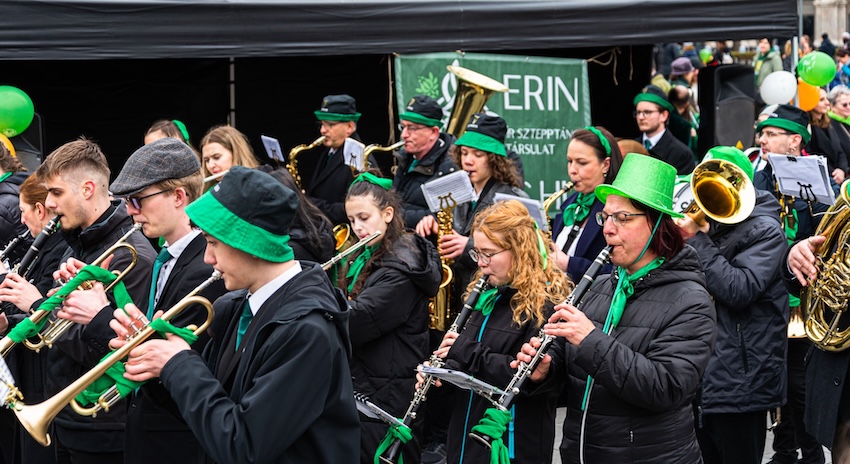
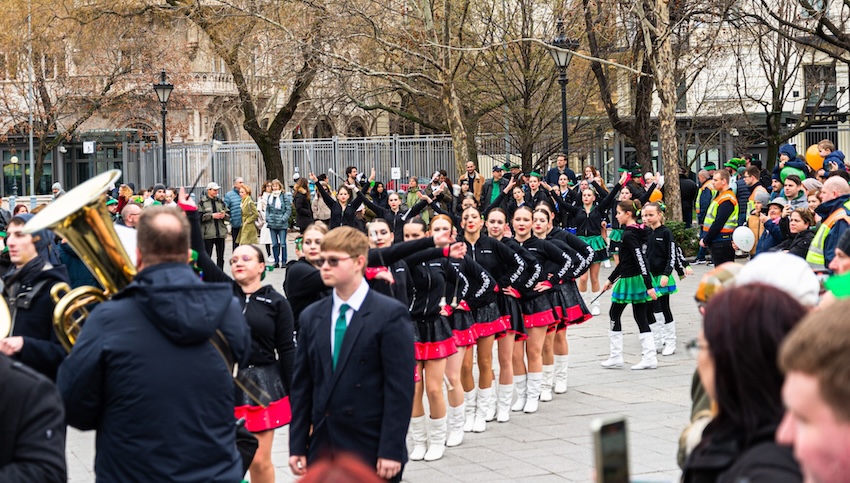


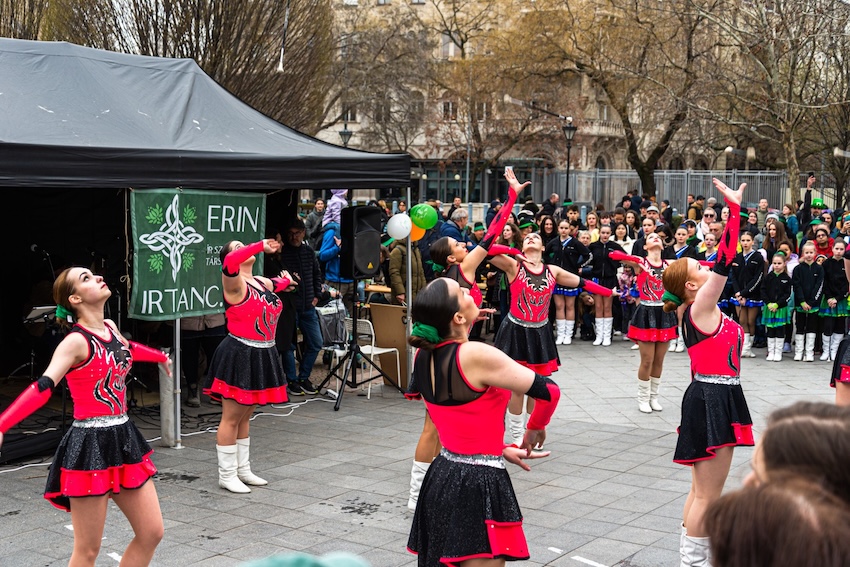
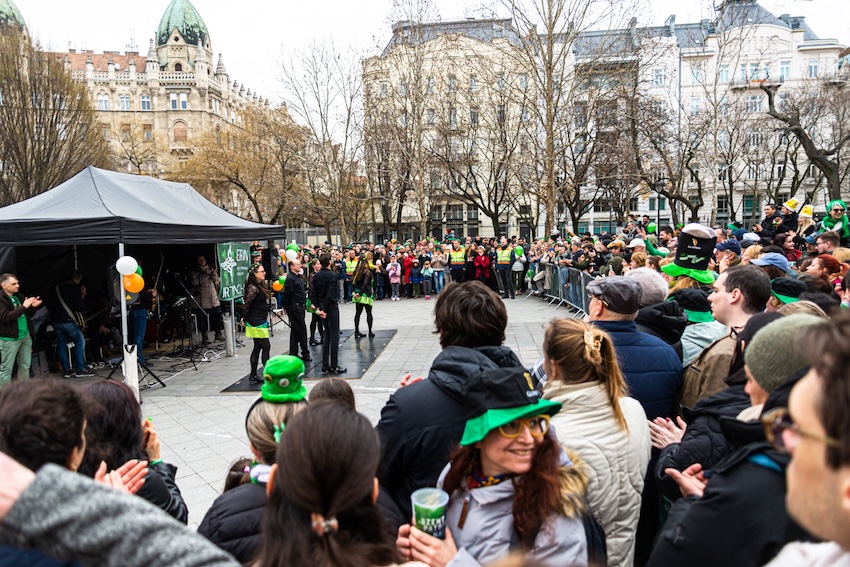
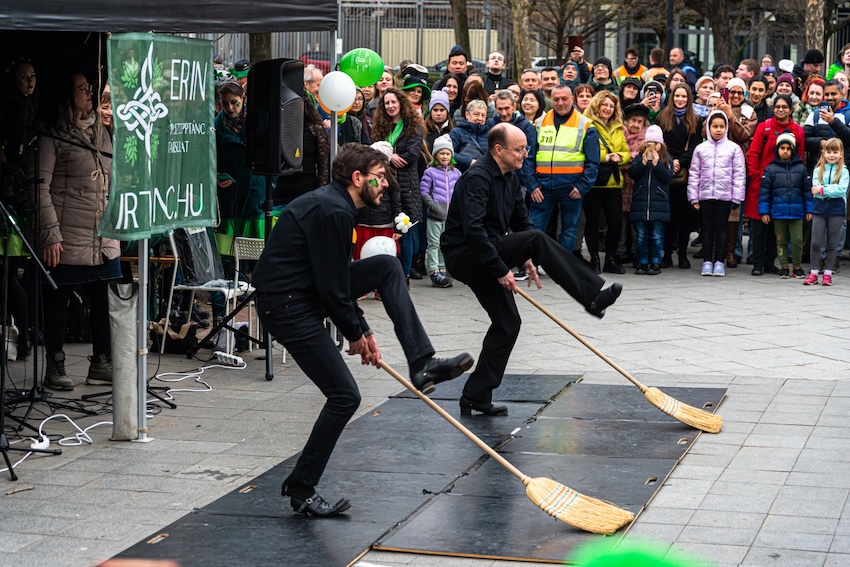
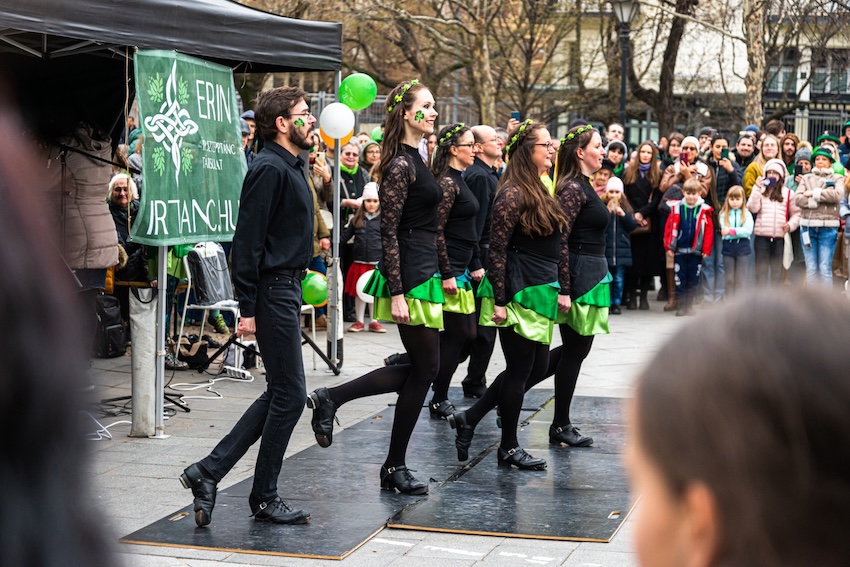
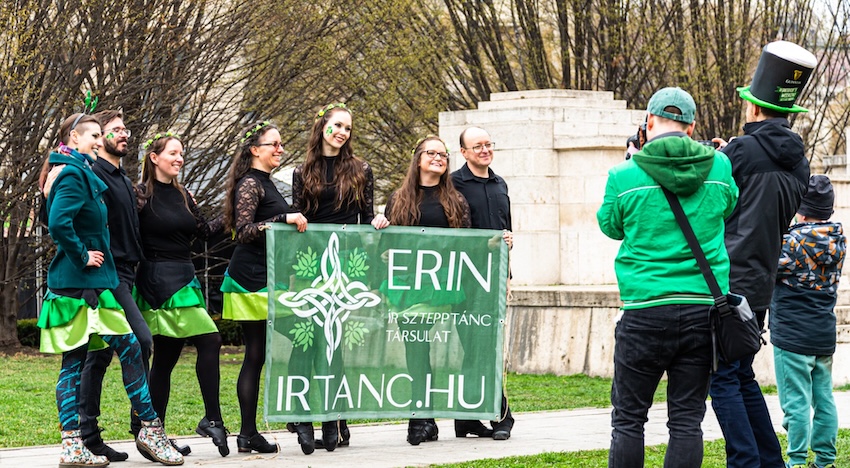
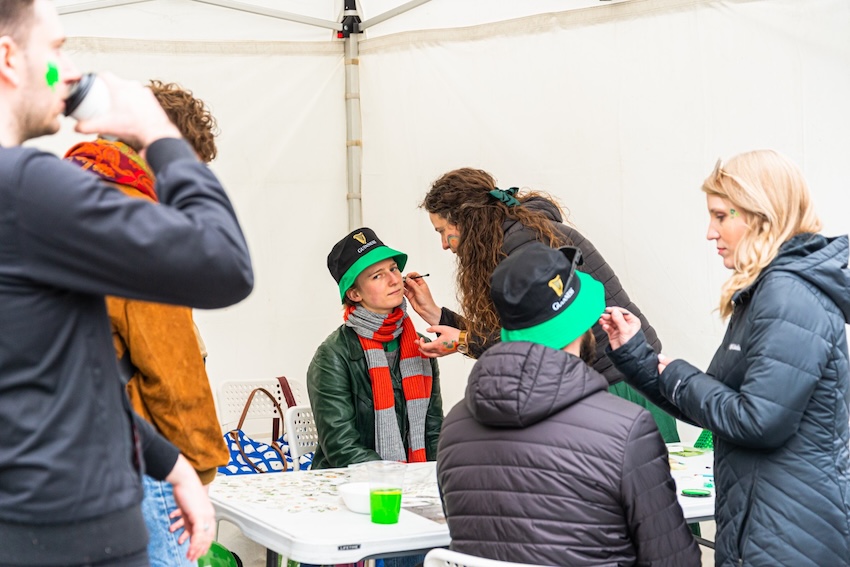
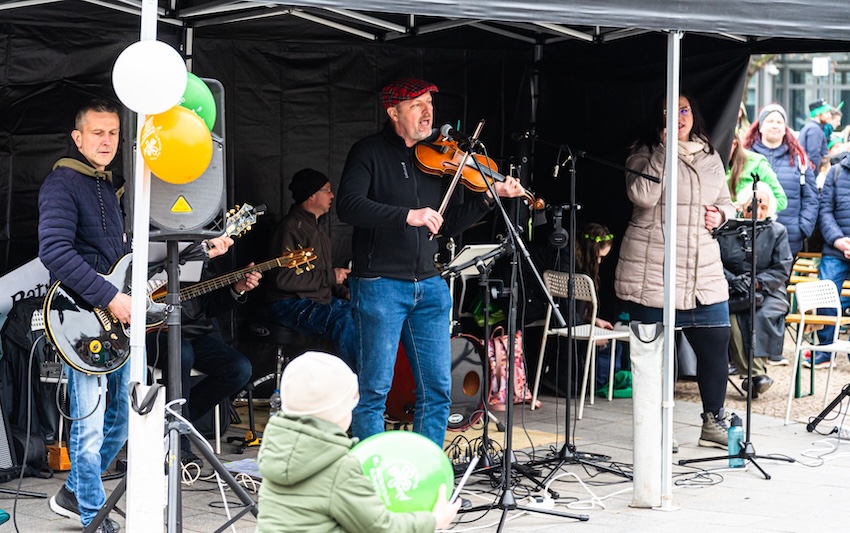
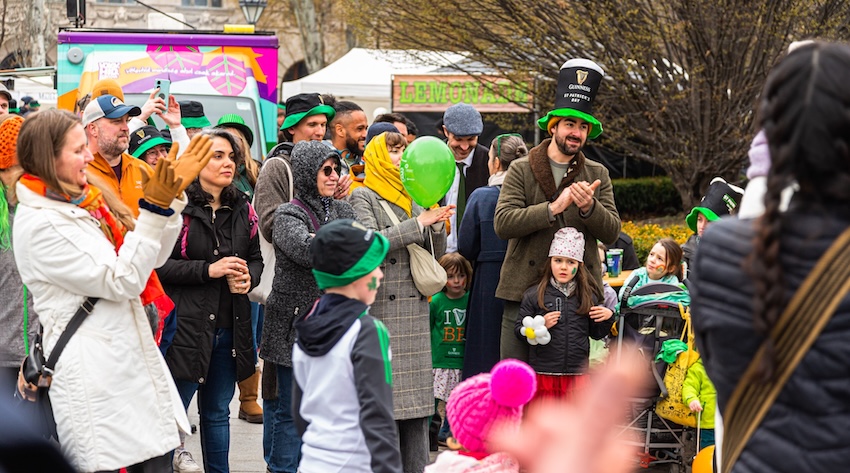
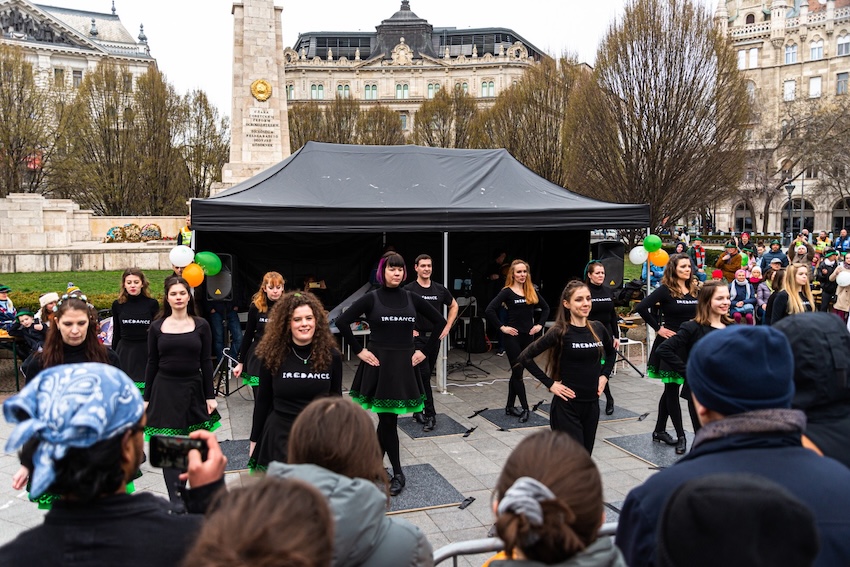
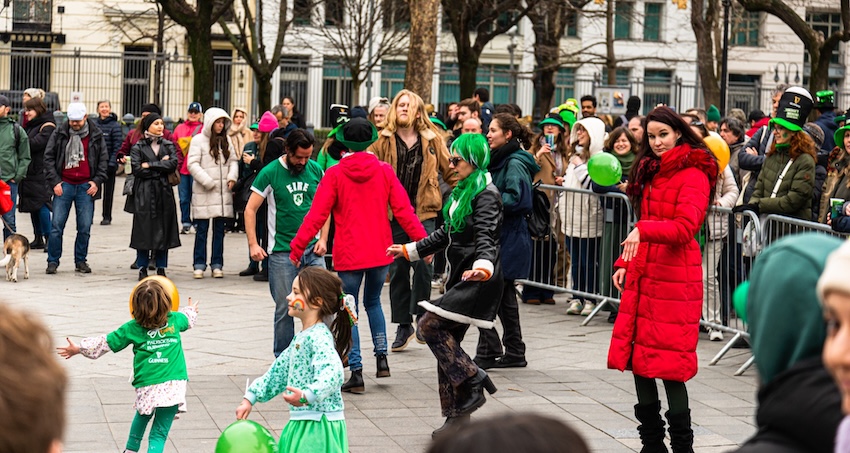
Among the distinguished guests, H.E. Ragnar Almqvist, Ambassador of Ireland to Hungary had the honour of leading the parade alongside prominent members of the Irish community. A special moment was the presence of the family of Henry Spelter, a renowned Budapest baker and one of the Hungarians who sought refuge in Dublin after the 1956 revolution. His famous “Mary Cake” remains a beloved staple on the menu of Bewley’s, Ireland’s most iconic café. Henry’s children, Eva and Henry Jr., and his granddaughter Carolina, travelled from the United States for the occasion. They were joined by baker Hazel Carmichael, granddaughter of Viktor Bewley, and Oscar Campbell, a senior manager at Bewley’s, making this celebration a heartfelt tribute to shared Irish-Hungarian ties.
A prominent symbol of St. Patrick’s Day is the colour green, which is deeply intertwined with Irish culture and history. It symbolizes not only the lush, verdant landscape of Ireland, but also the country’s Catholic heritage. On St. Patrick’s Day, cities around the world are decorated with green, and revellers wear green attire to partake in the festivities. Beyond its cultural significance, green also symbolizes rebirth and the onset of spring, thus contributing to the celebratory atmosphere of the day.
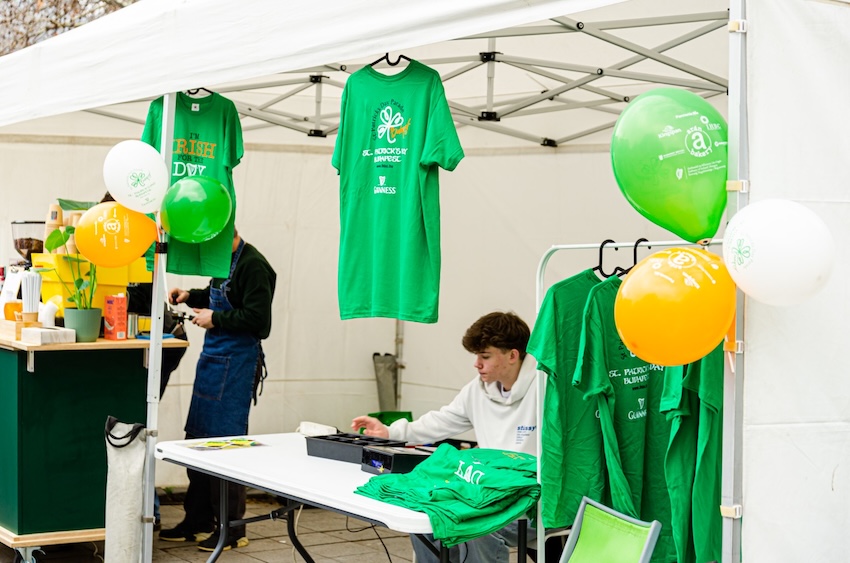
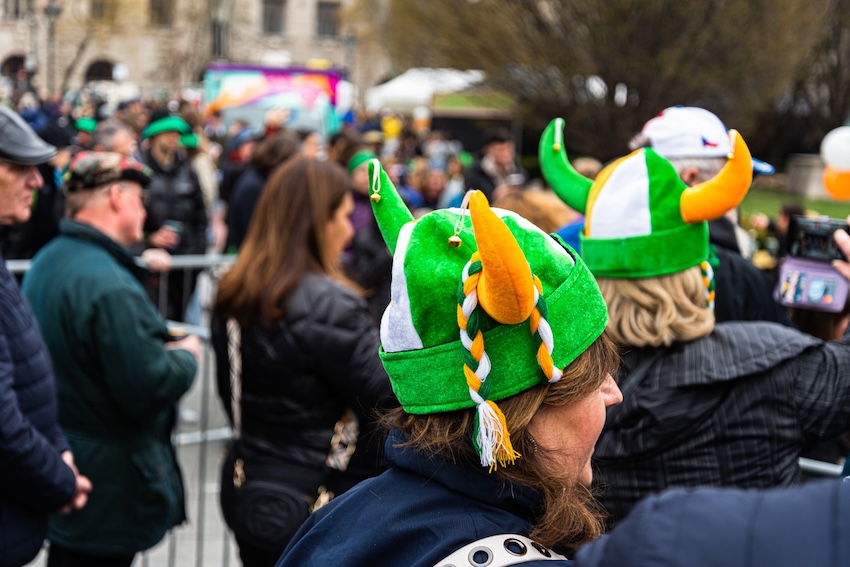
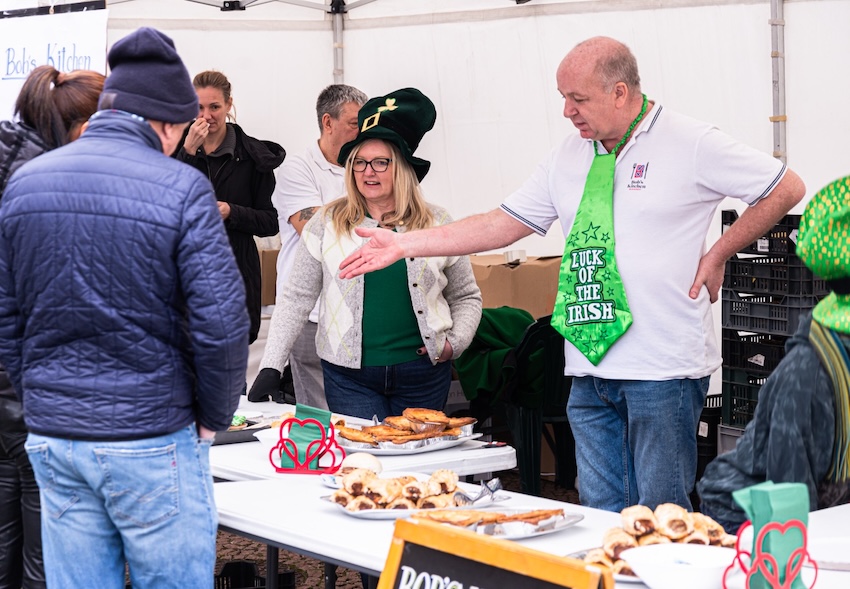

Another notable symbol of St. Patrick’s Day celebrations is the shamrock. Legend has it that St. Patrick used the shamrock to explain the concept of the Holy Trinity to the Irish people. Tradition holds that Patrick plucked a shamrock from the ground and utilized its three leaves to illustrate the three persons of the Holy Trinity: the Father, the Son, and the Holy Spirit. This simple yet impactful analogy is believed to have facilitated the conversion of many Irish people to Christianity. Consequently, the shamrock became associated with the holiday and is often worn as a symbol of Irish heritage and good fortune.
An Evening of Reflection and Celebration at CEU
On St. Patrick’s Day, 17 March, the Irish Embassy hosted a special reception at the Central European University (CEU). The campus was designed by the Irish architecture firm O’Donnell & Tuomey, and won the Royal Institute of the Architects of Ireland (RIAI) Award for Best International Project in 2017.
Several distinguished guests attended the event, including the Mayor of Budapest, Gergely Karácsony, the Mayor of Szombathely, András Nemény, and the newest members of the Irish community in Budapest – legendary Irish footballers Robbie Keane and Rory Delap, now coaching at Ferencváros (Fradi) Football Club.





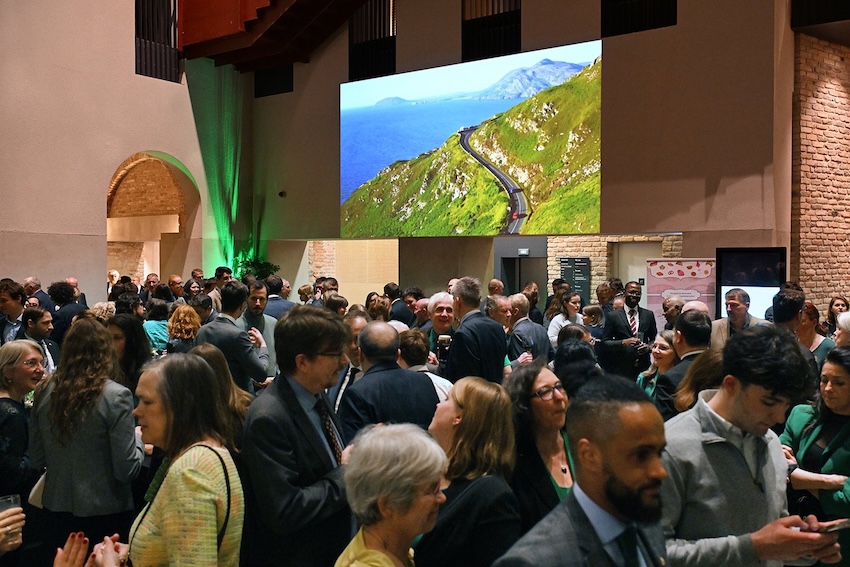
In his remarks, Ambassador Ragnar Almqvist reflected on the shared history, values, and cultural connections between Ireland and Hungary, paying tribute to the legacy of Henry Spelter:
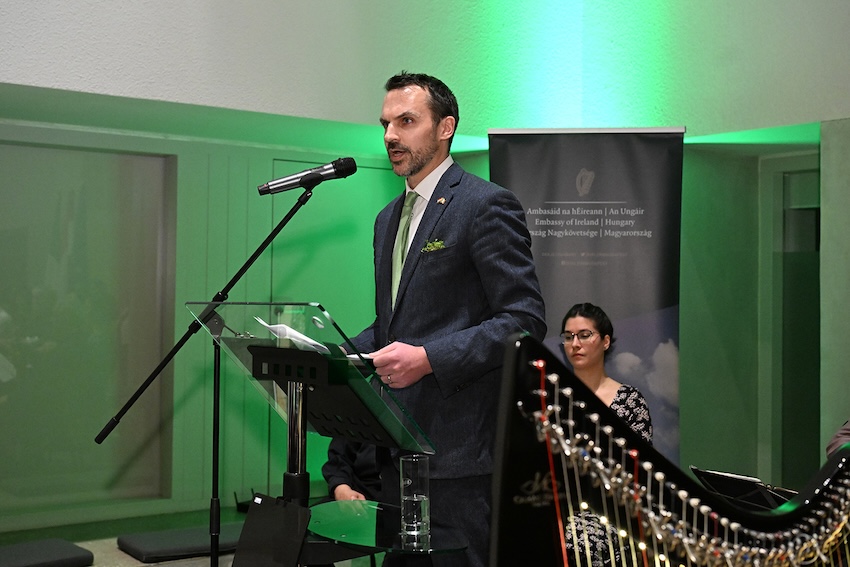
“Kedves Főpolgármester, Kedves Kollegáim, Kedves Barátaim! Esik az eső. Tökéletes ír este. Itt Magyarországon azt mondják – hétfőn még a fű se nő. De ez nem igaz a shamrockra. Legalábbis Szent Patrik napján.”
“Dear Mayor, Dear Colleagues, Dear Friends, it’s raining – a perfect Irish evening. Here in Hungary, they say – even the grass doesn’t grow on a Monday. But that’s not true for the shamrock – at least not on St. Patrick’s Day.”
“Ireland is known as the land of Saints and Scholars. Our Dean, the Nuncio, can confirm this. But I see no saints here this evening. Still, I am grateful that so many fine scholars are present. Here at CEU – a building designed, like the White House in Washington, D.C., by Irish architects, and like it, is inspired by the conviction that democracy, despite its imperfections, is the foundation of liberty.
It’s a belief that Magyars and Irish have long shared. And which, throughout history, has seen our people inspire each other. On Saturday, Sándor Petőfi’s Nemzeti Dal (National Song) echoed through Andrássy Avenue. In the lead-up to the revolution he inspired, Petőfi was one of three giants of Hungarian poetry, along with Mihály Vörösmarty and János Arany, to translate their Irish contemporary, Thomas Moore. In his stirring verse, Moore implored Irish patriots to ‘forget not the field where they perished, the truest, the last of the brave’.
I recalled these words today, remembering the Hungarian heroes of 1848 – but also the true and brave Ukrainians who, for three years now, have defended the golden fields of their homeland and the freedom of our continent. Among them is my newest diplomatic counterpart here, Fedir Shandor – a scholar, a soldier, now an ambassador. Welcome, Fedir. And thank you.
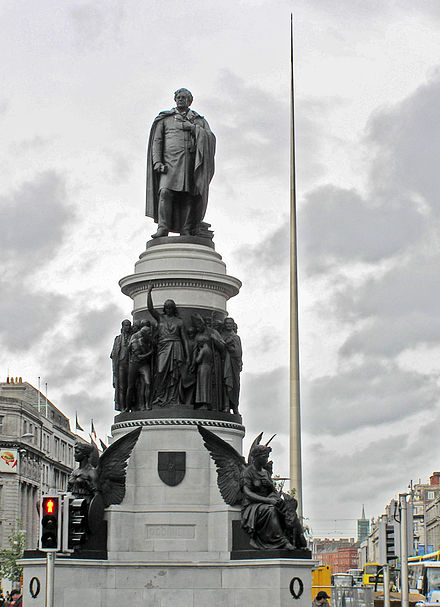
Born 250 years ago, Daniel O’Connell died a year before the Hungarian Revolution. Yet the man we know in Ireland simply as the Liberator was himself an inspiration to Lajos Kossuth, who often wrote about him in Pesti Hírlap.
O’Connell not only championed Catholic emancipation, but was also one of Europe’s great abolitionists. Famously, he observed: ‘Nothing is politically right which is morally wrong’. In a changing world, his words remain a lodestar for Ireland’s foreign policy. They underpin our steadfast solidarity with Ukraine – our commitment to its security, territorial integrity, and path to EU accession. They also explain our deep commitment to democracy, the rule of law, and fundamental rights – including freedom of association and assembly.
These are core EU values that apply equally to all its people, regardless of gender or sexual orientation. Furthermore, we firmly believe that multilateralism, for all its flaws, matters. Not, as my father’s compatriot, UN Secretary-General Dag Hammarskjöld put it, to bring us to heaven, but to save us from hell.
Barátaim – Dear Friends,
the Magyar and the Irish share many passions – a love of folk music. A taste for fine food and strong spirits. And, of course, an abiding passion for sport.
Hungary’s first gold medallist in Paris last summer – the nation’s athlete of the year – Hubert Kós is the son of a proud Cork man, Nick Kós, who is with us tonight. He is as loved by the Leeside as he is on the Danube.
While Hungary claimed Hubert, our footballers can boast a striker of Hungarian heritage – Sammie Szmodics – who will face the mighty Magyars in this autumn’s World Cup qualifiers. Sammie may get some tips beforehand from the greatest striker in Irish football history – who was appointed coach of Ferencváros in January.
Robbie Keane is an icon of Irish sport. As is his assistant, Rory Delap – the only man I’d bet on to throw a football across the Danube! We are proud to welcome both to our small but vibrant Irish community, which turned Szabadság tér and the Chain Bridge Fradi green yesterday – with the backing of brilliant Irish companies and the incredible Irish-Hungarian Business Circle.
Kicsi a bors, de erős. És hajrá Fradi! – Small but mighty. And go Fradi!
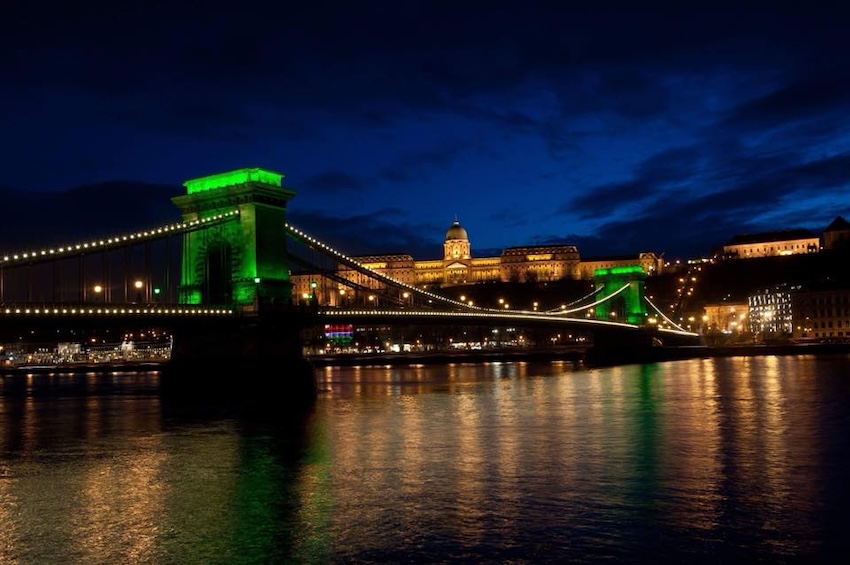
Like a few ambassadors here tonight (whom I won’t name), before I could spell diplomacy, I dreamed of being a footballer. Less known is that I also aspired to be a baker. My patisserie skills are no better than my passing, but I still love baking. And I’m in the right city for it. Of all Budapest’s remarkable pékségek (bakeries), my favourite is in the storied Jewish quarter.

Arán – the Gaelic word for ‘bread’ – boasts a sourdough named in honour of St. Patrick. And, of course, it tastes heavenly. Kinga and Attila Pécsi founded it in 2021 after returning home from a happy decade in Dublin, where Kinga earned a baking degree. They are among the 10,000 Magyars who have settled in Ireland. As the son of a migrant myself, from a nation enriched by multiculturalism, I see their story as a testament to the richness that comes with cultural exchange.
One pastry holds special significance tonight. Founded in O’Connell’s lifetime, Bewley’s is Ireland’s most celebrated café. In 1956, it employed Henry Spelter – one of 540 Hungarian refugees welcomed to Ireland after the revolution. Henry, a talented confectioner from a renowned Hungarian baking family, came up with a marvellous creation – the Marika Cake, later renamed Mary Cake for Irish audiences. For decades, Dubliners savoured its rich flavours. Henry later moved to America, Bewley’s menu changed, and his recipe was lost. But three years ago, Hazel Carmichael, granddaughter of Viktor Bewley, set out to rediscover it. She found the Spelter family in the USA and together they brought the Mary Cake back to Bewley’s, where sales have since raised funds for the Irish Red Cross to support Ukrainians displaced by Russia’s invasion.
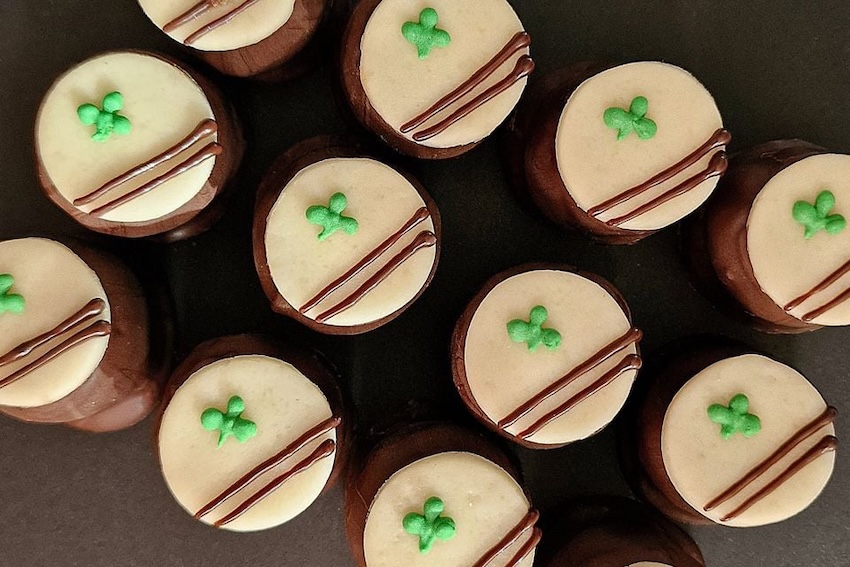
It is an honour to welcome Henry’s children, Eva and Henry, his granddaughter Carolina, and Oscar Campbell from Bewley’s. I am especially grateful to Hazel and her husband, Jonathan, who spent the past week baking mini Marys for this occasion. Try them. You’ll see: Yes, Ben Stiller was right. There is something about Mary. But there’s something about Hazel, too. And about Kinga. Just as there was about Henry Spelter. Namely that, dark as history can sometimes feel, kindness echoes through ages.
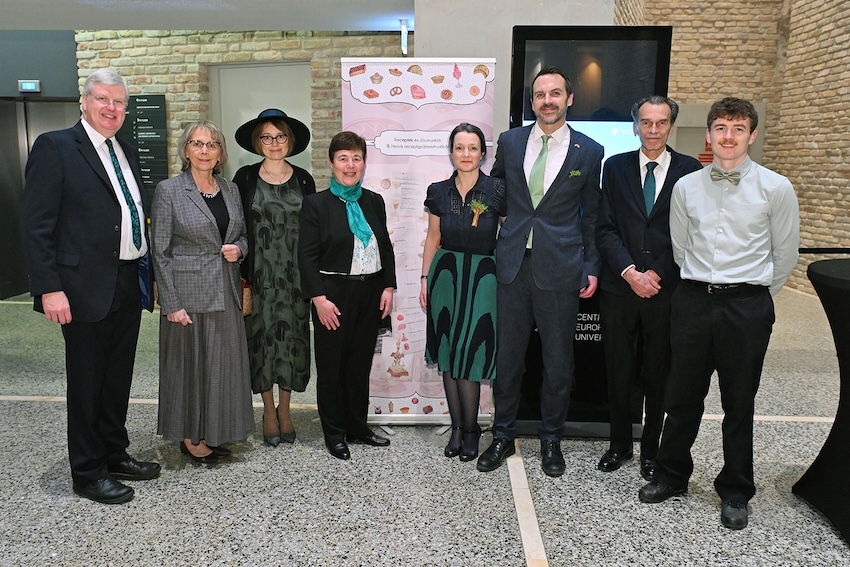
Barátaim,
I’m lucky to often experience such kindness here – in my loving family, through our tireless Embassy team, through the warmth with which so many amazing Magyar welcome us. Ireland doesn’t boast quite as many Nobel laureates as Hungary. But we have our share. One of them, George Bernard Shaw, joked that patriotism is ‘fundamentally a conviction that a particular country is the best in the world because you were born there…’

On 17 March, the world celebrates a particular country. But the Saint in whose name we gather was not born there. As a boy, Patrick was abducted in his native Briton, carried across the Irish Sea. Six years a slave, a solitary shepherd on a stony Antrim hillside, he escaped and returned home. But like many who leave our shores, Ireland never left his soul. And decades later, he braved the narrow seas again. He converted our country to Christianity and changed the course of its history.
Whatever your religion, or none, Patrick was a patriot. As, to my mind, all here are. Not because we’re convinced the country of our birth is the best in the world. But because we believe the world can be better for our country’s place in it.
As you’ve heard, being the son of folklorists, I’m fond of folk wisdom. ‘Három a Magyar igazság’ is my favourite közmondás (proverb). And, like the Hungarian justice, the leaves of St Patrick’s shamrock are also three.”
“So, join me in raising your glasses. And tipping them three times:
To Robbie Keane, Nick Kós and all the Irish who have made Hungary their home.
To Henry Spelter, Kinga Pécsi and the many Magyar who have enriched Irish culture.
To our common home in the European Union. This continent’s greatest peace project. And to the values on which it is founded – and which so many here are so committed to protecting.
Egészségedre. Sláinte. Cheers.
Agus Lá Fhéile Pádraig shona daoibh go léir! And a happy St. Patrick’s Day to you all.”
The Irish Around the World
With around 80 million people worldwide claiming some Irish ancestry, St. Patrick’s Day is a source of immense pride and a joyous occasion celebrated across the globe. Ireland’s history has been profoundly shaped by waves of emigration, as generations sought new opportunities abroad. Former Irish President Mary Robinson – the first woman to hold the office (1990–1997) and widely regarded as one of the most influential Irish women of the 20th century – once remarked: “After all, immigration isn’t just a chronicle of sorrow and regret, but also a powerful story of contribution and adaptation.”
St. Patrick’s Day Gala Dinner
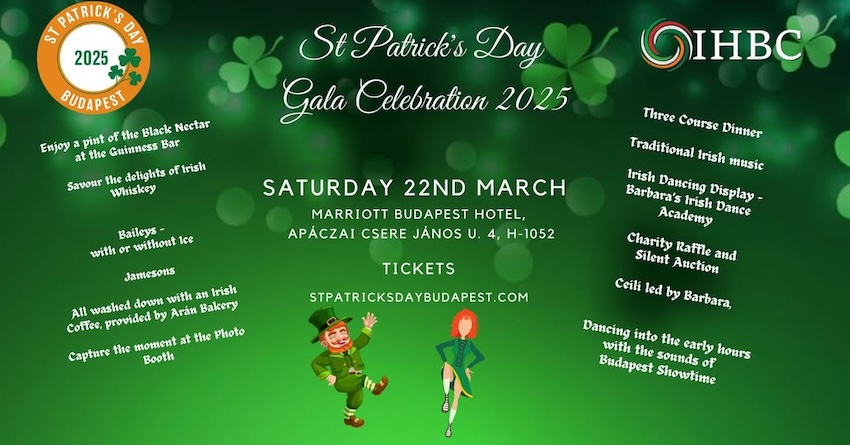
The 2025 St. Patrick’s Day festivities culminated in a traditional Gala Celebration hosted by the Irish-Hungarian Business Circle (IHBC) on 22 March at the Marriott Budapest Hotel. This vibrant charity event featured an exquisite dinner, lively music, dancing, and an evening of fun and entertainment.
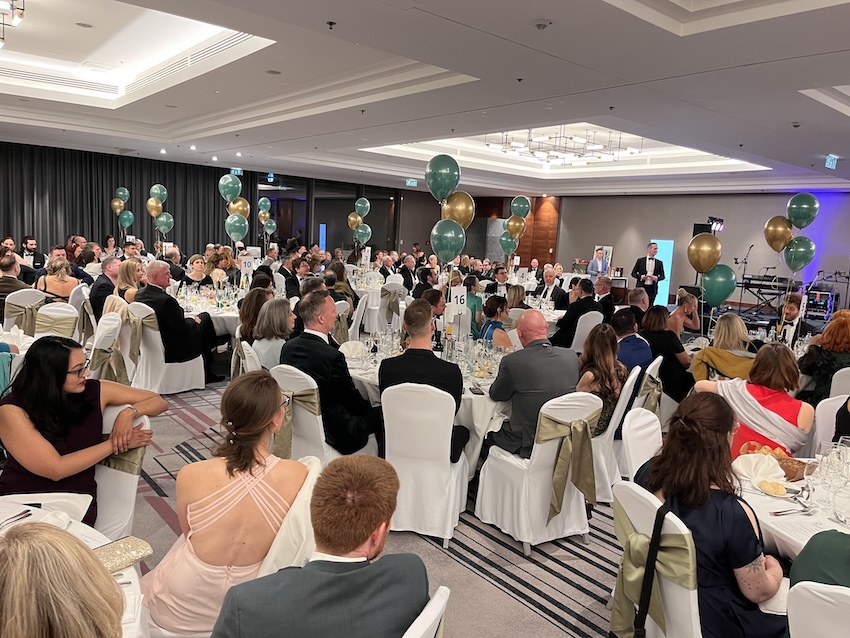
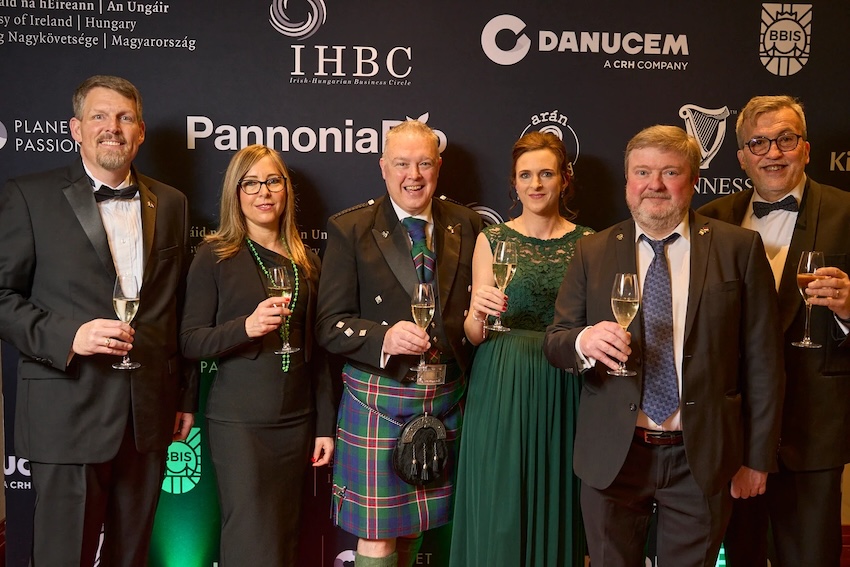

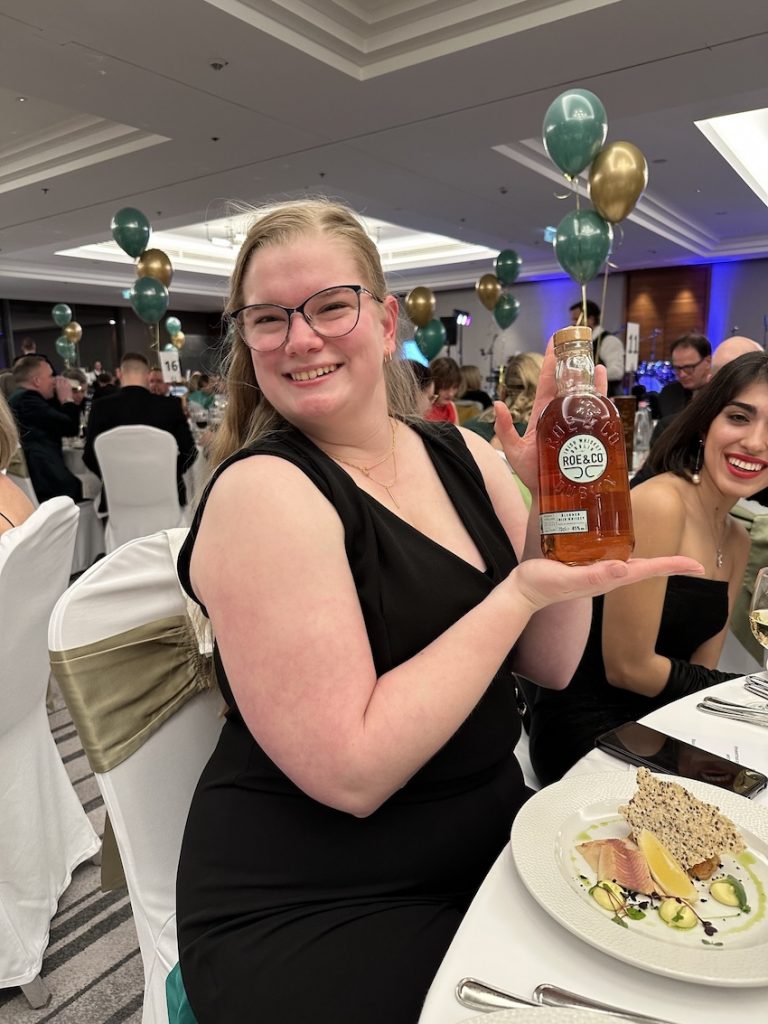
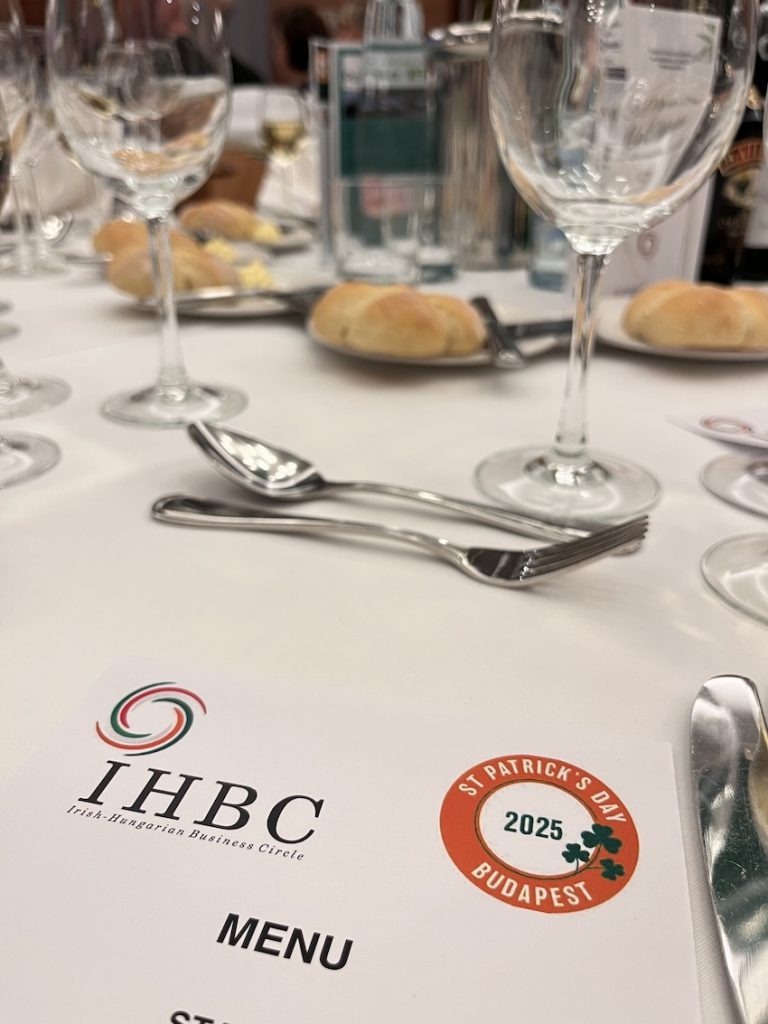
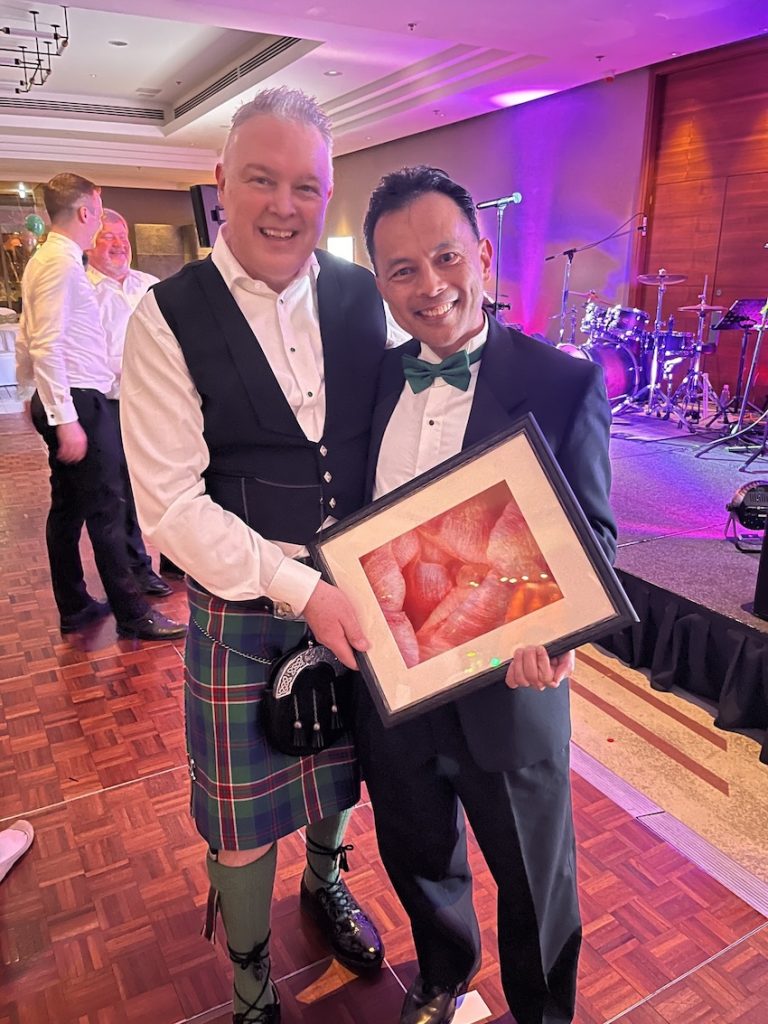
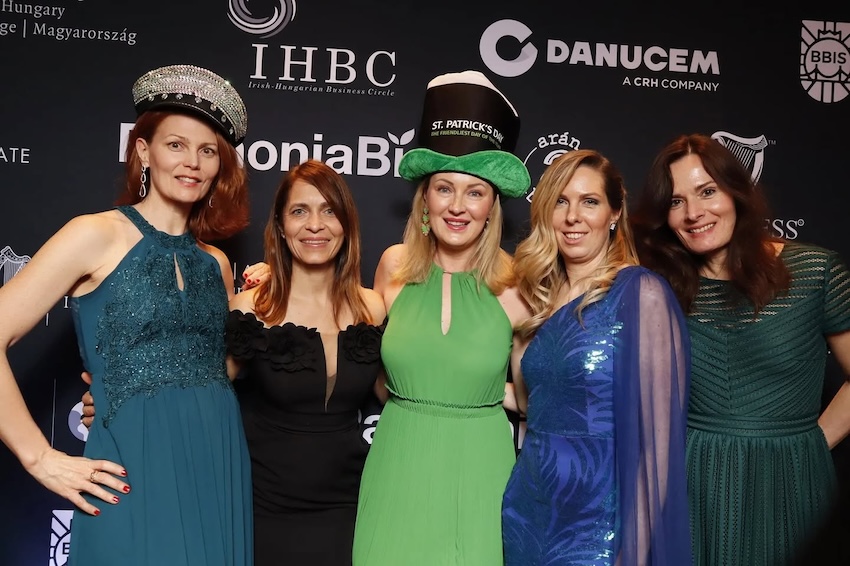


Thanks to the generosity of the guests and the support of the raffle sponsors, 3,000,000 HUF was raised for charity. The funds will benefit NANE and TAMI (Tarnabod és Mi), Hungarian organizations dedicated to important social causes.

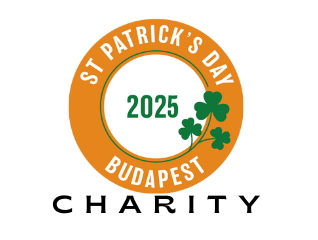
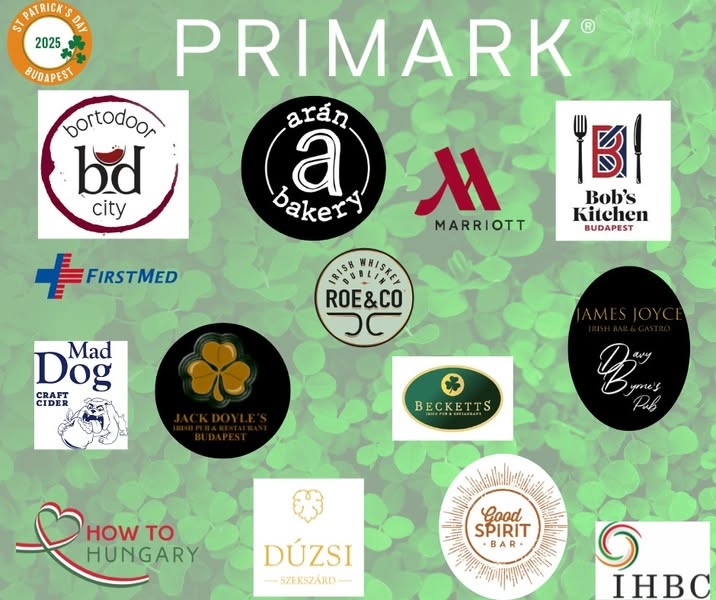
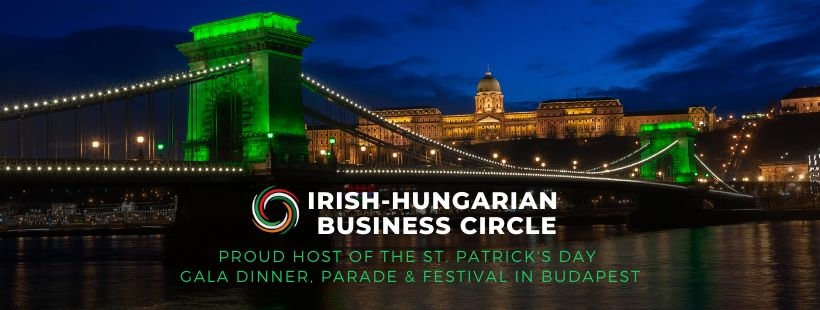
Sources: Embassy of Ireland in Budapest, Irish-Hungarian Business Circle (IHBC)
Photos by Zoltán Pelle, the Embassy of Ireland in Budapest, and the Irish-Hungarian Business Circle (IHBC)

